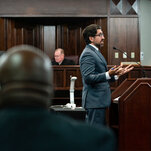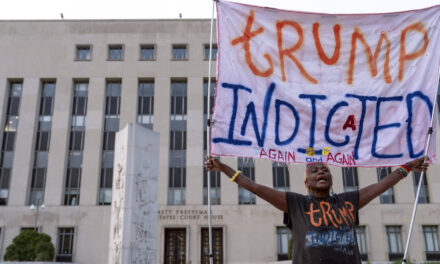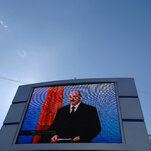
Nearly All-White Jury in Arbery Killing Draws Scrutiny

The guidelines that allowed the judge to seat a panel with one Black juror were meant to remove bias from the process but have come to be considered a failure by many legal scholars.
Video
transcript
transcript
Judge Refuses to Reseat Mostly White Jury in Arbery Case
Judge Timothy R. Walmsley of Glynn County Superior Court acknowledged that many Black jurors were excused by the defense. The jury includes 11 white people and one Black person.
-
This court has found that there appears to be intentional discrimination in the panel. That’s that prima facie case. And I guess before I get into this, one of the challenges that I think counsel recognize in this case is the racial overtones in the case. Quite a few African American jurors were excused through preemptory strikes exercised by the defense, but that doesn’t mean that the court has the authority to reseat. The court is in a position where it’s got to make another finding, which is that the defendants are not genuine when they gave reason, and that the reason they were claiming is not the real reason those particular jurors were struck. The court is not going to place upon the defendants of finding that they are being disingenuous to the court or otherwise are not being truthful with the court, when it comes to their reasons for striking these jurors. So because of that and because of, again, the limitations I think [unclear] places upon this court’s analysis, I’m denying the motion.

BRUNSWICK, Ga. — Even as he approved the selection of a nearly all-white jury this week to hear the murder case against three white men accused of killing Ahmaud Arbery, a Georgia judge declared that there was an appearance of “intentional discrimination” at play.
But Judge Timothy R. Walmsley of Glynn County Superior Court also said that defense lawyers had presented legitimate reasons unrelated to race to justify unseating eight Black potential jurors. And that, he said, was enough for him to reject the prosecution’s effort to reseat them.
What may have seemed like convoluted logic to non-lawyers was actually the judge’s scrupulous adherence to a 35-year-old Supreme Court decision that was meant to remove racial bias from the jury selection process — but has come to be considered a failure by many legal scholars.
The guidelines established by that ruling were central to the intense legal fight that erupted in court late Wednesday over the racial composition of the jury in the trial of the three defendants, which is set to begin on Friday. The argument raised fundamental questions about what it means to be a fair and impartial juror, particularly in a high-profile trial unfolding in a small, interconnected community where nearly everyone has opinions about the case.
Defense lawyers told Judge Walmsley there were important, race-neutral reasons to unseat several Black candidates for the jury. One man, they said, had played high school football with Mr. Arbery. Another told lawyers that “this whole case is about racism.”
But the fact that the jury will be composed of 11 white people and one Black person in a Deep South trial over the killing of a Black man has profoundly dismayed some local residents who already had concerns about whether the trial will be fair.
Image

“This jury is like a black eye to those of us who have been here for generations, whose ancestors labored and toiled and set a foundation for this community,” said Delores Polite, a community activist and distant relative of Mr. Arbery, who was fatally shot last year after being chased by three men who suspected him of a series of break-ins.
More broadly, the racially lopsided jury, in a county that is about 27 percent Black and 64 percent white, underscores the enduring challenges that American courts face in applying what seems to be a simple constitutional principle: that equal justice “requires a criminal trial free of racial discrimination in the jury selection process,” as Justice Brett M. Kavanaugh put it in a ruling from 2019.
At the heart of the matter in the Georgia case, and many others like it where white people dominate the jury box, is the ability of lawyers to issue a limited number of peremptory challenges — which usually require no explanation — to strike potential jurors from the process. Lawyers typically have wide discretion, but in a landmark 1986 case, Batson v. Kentucky, the Supreme Court ruled that lawyers could not discriminate on the basis of race in issuing the challenges.
Since then, lawyers who suspect the other side of unseating a juror on racial grounds can contest it, a move often called a “Batson challenge.”
That is what unfolded for almost two hours on Wednesday at the Glynn County Courthouse, as defense lawyers walked Judge Walmsley through the detailed reasons they believed that each of the eight Black residents should not be seated, such as the pro-Arbery hashtags that some potential jurors had posted online or the negative opinions they had formed about the three defendants — Gregory McMichael, 65; his son Travis McMichael, 35; and their neighbor William Bryan, 52.
Laura D. Hogue, one of the lawyers for the elder Mr. McMichael, described peremptory strikes as an important tool that allowed lawyers “to weed out the worst of the worst,” by which she meant people who seemed to be irredeemably biased.
The lead prosecutor, Linda Dunikoski, pushed back in every case. She argued that a number of potential jurors were honest with lawyers about their knowledge and opinions about the case, but were then unseated by the defense on the basis of those opinions — even when they stated that they could be impartial if seated.
Ms. Dunikoski also noted that the 12-person jury had been selected from a panel that included 12 Black people and 36 white people — and yet, she said, “the actual jury that was selected has only one African American male on it.” The prosecution used all 12 of its peremptory strikes on white potential jurors.
Image
Judge Walmsley spoke like a man whose hands were tied by the law. “I’ll tell you,” he said at one point, “in this case, Batson’s limitations, I think, are clearly out there.”
Outside the courthouse on Thursday, activists argued that the process was essentially broken.
“This is not race neutral,” said Barbara Arnwine, a lawyer and member of a group called the Transformative Justice Coalition. “This was racial targeting of Black jurors. It was disingenuous to lie and pretend this was about anything other than getting rid of Black jurors.”
Understand the Killing of Ahmaud Arbery
Card 1 of 6
The shooting. On Feb. 23, 2020, Ahmaud Arbery, a 25-year-old Black man, was shot and killed after being chased by three white men while jogging near his home on the outskirts of Brunswick, Ga. The slaying of Mr. Arbery was captured in a graphic video that was widely viewed by the public.
The case against the men accused of killing Mr. Arbery is a rare one in which a prosecutor issues Batson challenges; they are more typically issued by defense lawyers trying to prevent prosecutors from booting minorities out of the jury selection process. A number of studies have focused on prosecutors, finding that they have removed Black jurors at double or triple the rates of other people in states like Alabama, Louisiana and North Carolina.
The efficacy of Batson as a tool to remove racial bias in the jury selection process has come under serious criticism in recent years by legal scholars. In a California Law Review article last year, the lawyer Annie Sloan argued that Batson was now “widely considered to be a toothless and inadequate decision that fails to reduce the unfair exclusion of jurors of color.”
Ms. Sloan noted that Batson challenges were rarely successful, in part because it was too easy for lawyers to come up with a race-neutral justification for their strike. And she argued that Batson did not take into account implicit bias, meaning that lawyers might strike jurors for racial reasons without even realizing it.
Ms. Sloan pointed to what she deemed a hopeful modification of Batson by Washington State, where a 2018 State Supreme Court rule forbids peremptory challenges if an “objective observer” deems jurors’ race or ethnicity to be a factor in unseating them.
California adopted a similar approach in 2020. Arizona will ban the use of peremptory strikes starting Jan. 1.
Some legal scholars critical of Batson believe that peremptory strikes still have their place, serving as an important check against biased jurors. Stephen B. Bright, a professor at Yale Law School and Georgetown Law, said he favored limiting the number of peremptory strikes to three per side.
In Brunswick on Wednesday, Judge Walmsley mentioned Washington as one of the states “that’s looked at Batson and recognized the limitations it places on the court.” In Georgia, he noted that all that lawyers need to overcome a Batson challenge is to deliver an explanation that is “legitimate, nondiscriminatory, clear, reasonably specific and related” to the case.
The concern now in Brunswick is that faith in the justice system has been undermined by the selection of a racially imbalanced jury.
Charlie Bailey, a former senior assistant district attorney in Fulton County, Ga., recognized the constraints that the law placed on the judge. Still, he described the jury composition as fundamentally unfair to the community, and to Mr. Arbery’s family.
“Eleven of 12 is 11 of 12,” said Mr. Bailey, a Democrat who is running for Georgia attorney general. “It’s hard for me to believe — and I think it’s hard for most people to believe — that 11 of 12 did not have anything to do with race.”
Source: https://www.nytimes.com/2021/11/04/us/ahmaud-arbery-trial-jury.html


















